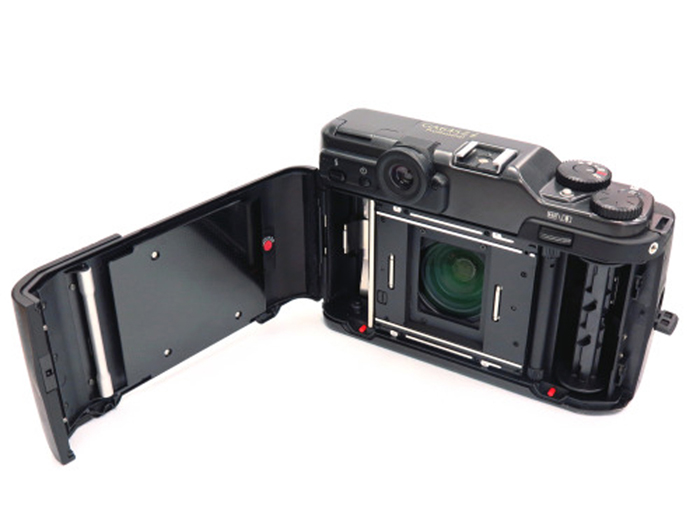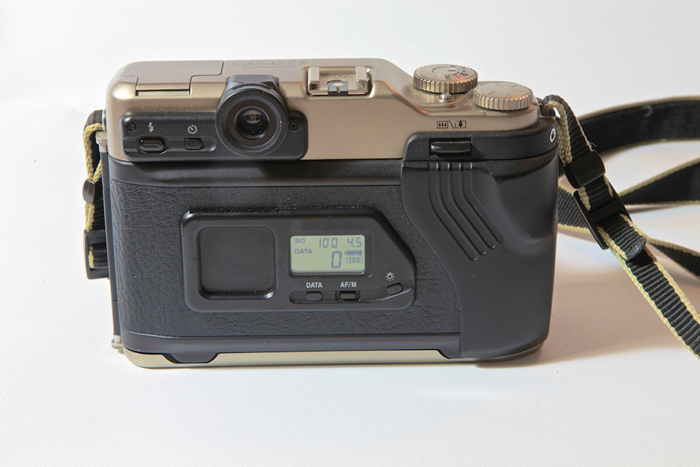SEARCH






|
|
|
|


This will not be a technical review, or a full test drive packed with scientific jargon and graphs that nobody will read or understand. This will be a love declaration. This will be a praise for a tool, since this camera will lead you the way toward a fine print.

The photographer's tool is the camera. If digital is your path, you can get along with only one camera, and maybe a zoom lens. I only use conventional film cameras, with three types of film, small, medium and large, and one camera is not enough. I have several for every film size format and task. But there is one I love the most, the one I have close to me all the time, the one I always carry in my bag when travelling abroad. At airports, it almost always gets stopped by the inspector, but we all end up having fun demonstrating the camera and how it works.
If you have been reading my previous articles in the magazine, you may have tried your hands on some film camera
for small format, also known as 35mm, medium format or large format. The latter may be too big and complicated for a beginner, and the small format may not give you many advantages. Medium format is used by a full range of cameras centered around the 120 film roll and different ways it is sliced into frames inside the camera, rectangles of various proportions or squares.
As can be seen, sizes can range from 6x4.5...to...x17 inches, or bigger if a camera can be devised to deal with that. And the bigger the format, the bigger the camera.
Ask yourself: How much of your work depends on a portable camera? If the answer is much, then we need camera that can be readily portable without compromising image quality.
GA645Zi is the tool I propose, most useful for film photography. To your surprise, with this simple camera you can get portability and superb image quality, with amenities like precise light measurement and auto-focus, on a 3x larger negative than with a 35mm camera or your full frame digital sensor Camera.

This camera, made in Japan by Fujifilm first in 1998, is no longer in production. But it is still widely available at usual second hand places and sites, at prices around $350. A good value, for what it delivers.
The main big advantages are:
-a truly portable medium format camera that you can squeeze into your cabin bag in a plane.
-light measuring and auto-focus, a true point and shoot.
-high quality integrated lens with zoom feature from 55mm to 90mm.
The frame count per roll of film is low, about 16 frames per roll. With the absence of preview dependent on the intended style of photograph, you have to think carefully to optimize all conditions, before taking any picture.
As for me, digital has fewers surprises, every picture can be so perfect and controllable all the time. However traditional shooting is more unpredictable, and that is so much more interesting to me. The thrilling of coming home with a box of surprises and wonders. The nervous waiting for it to develop and having the first look at it after all the wracking wait. That first look at the roll still wet, against the light, and that is pure fascination. Sometimes all is transparent, nothing was recorded, sometimes all is black, which happens too. But every perfectly exposed frame will be an achievement in proficiency, something to be proud of, to stare at.
With a digital camera you don't get that, other joys for sure, but not that. Remember, only 16 pictures per roll. No second chance. As an example, a few years ago I went to Venice, Italy. My first and only time there. My GA was my faithful companion. I exposed several rolls black and white, and a few colour negatives and slides. Most came out well, some perfect captures here and there, but in the end only one black and white and one slide emerged as truly remarkable and memorable, and that made my trip and that journey worthwhile forever. The joys of shooting film. With a digital camera it would have been a completely different story.
Here some technical facts: at the core of this magnificent camera is a super-ebc Fujinon zoom lens. The zoom is not continuous, it increases in steps, 55, 65, 75 and 90 mm. Minimum focus distance is 9cm. The filter thread is 52mm, and usually the camera comes with a special unique fit that is useful to prevent flare. Since a rangefinder camera, parallax has to be assessed, but the viewfinder offers a way to correct for it with precise lines. The viewfinder also offers dioptre correction if you need it. Following camera construction on the small side, the normal position frame is in portrait orientation, most peculiar but very interesting. It also has the capacity to write date and exposure data on the negative margins. I just love it!
The auto-focus is extremely precise. The exposure system is center-weighted and completely reliable if you adhere to the basics, for example not pointing the lens to the sky only if you want texture. Exposure compensation is available, and several common modes of operation are also very intuitive to use on easy accessible dials. The operation settings and adjustments are all visibleon the back LCD. There is also a built-in flash, very handy in some situations, and useful connections such as PC flash sync and remote cable. Film transportation is motorized.. The camera needs two commonly available CR123A batteries, which almost last forever.
Ok, the brave ones are convinced! You may want to try this camera. You won't regret it.

Here some further important advice, based on my personal experience of many years: if you consider buying online, or live, look carefully into the LCD on the back door, ask for it to be lit, get assured it is working, demand some guaranties on it, only buy one where you can see black and fully showing letters and numbers! Never buy one with a fading screen or some letters and number parts missing. All electronics on the camera run through there. If the screen does not work, then the camera cannot be properly operated. Some repair shops can fix the problem, but usually it’s almost impossible or too expensive to do. I learned it the hard way, already had two cameras that failed after a while because of this issue.
The current and third camera I bought has a perfect looking back LCD and it has been working wonderfully for several years. I hope it lasts as I couldn't live without it. I have had cameras that broke and were gone forever. But not my GA. If one is lost, I have to replace it!
For a few more bucks, if you can afford it, get a black model. It came out one year after the golden one, only sold in Japan, and I have heard they have more reliable electronics.

In the end, look for the usual, such as clean optics and not too many scuffs or other marks of use. The best is to inspect the camera in hand before you buy it, if that is possible. Open the back door and look inside. Ask to try a roll and see how it goes. The lens should render the colours beautifully, black and white should give you full contrast, the negatives will be sharper than the sharpest razor. It is pure delight!
This is the camera you can only love as much as I do, taking it around anywhere any place. It won't let you down. Just stick in a Delta 100, a 160NS maybe, or whatever suits you at the moment and go out having fun... and let me know how it went!
 | Write |